
Dillwynia tenuifolia is a species of flowering plant in the family Fabaceae and is endemic to eastern New South Wales. It is an erect shrub with linear leaves, and orange-yellow and red flowers.

Banksia cirsioides is a species of shrub that is endemic to Western Australia. It has pinnatisect leaves with between six and ten lobes on each side and hairy heads of yellow and pink flowers.
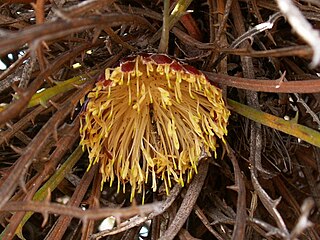
Banksia comosa, commonly known as Wongan dryandra, is a species of shrub that is endemic to Western Australia. It has linear leaves with widely spaced, sharply pointed serrations, heads of yellow flowers and glabrous fruit.

Banksia hewardiana is a species of openly branched shrub that is endemic to Western Australia. It has linear, serrated leaves with sharply pointed teeth, head of up to sixty lemon-yellow flowers and oblong follicles.

Banksia horrida, commonly known as prickly dryandra, is a species of shrub that is endemic to Western Australia. It has hairy stems, linear, pinnatifid leaves with sharply pointed teeth on the edges, up to sixty cream-coloured flowers in each head and hairy, egg-shaped follicles.
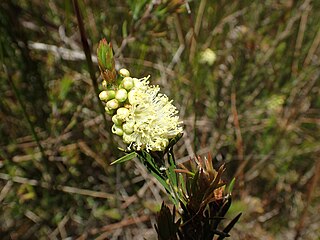
Melaleuca paludicola, commonly known as river bottlebrush, is a plant in the myrtle family Myrtaceae, and is endemic to eastern Australia. It is a shrub or small tree with flexible, often drooping branches, pinkish new growth and spikes of cream, pale yellow, or sometimes pink flowers in summer.
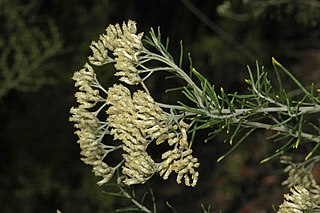
Cassinia uncata, commonly known as sticky cassinia, is a species of flowering plant in the family Asteraceae and is native to inland New South Wales and the south-east of South Australia. It is an erect shrub with hairy young stems, narrow linear to needle-shaped leaves, and heads of off-white to cream-coloured flowers arranged in rounded, almost conical panicles.
Persoonia rudis is a species of flowering plant in the family Proteaceae and is endemic to the south-west of Western Australia. It is an erect shrub with hairy young branchlets, linear leaves, and yellow flowers borne in groups of five to thirty on a rachis 3–100 mm (0.12–3.94 in) that continues to grow after flowering.
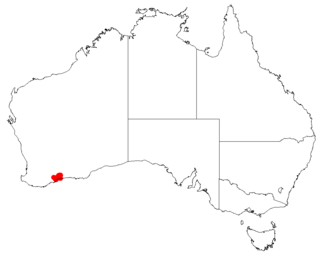
Persoonia dillwynioides, commonly known as Fitzgerald persoonia, is a species of flowering plant in the family Proteaceae and is endemic to a restricted area in the south-west of Western Australia. It is an erect, spreading shrub with smooth bark, linear leaves and bright yellow flowers borne singly or in groups of up to four along a rachis up to 3 mm (0.12 in) long.
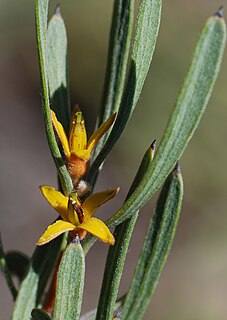
Persoonia trinervis is a species of flowering plant in the family Proteaceae and is endemic to the south-west of Western Australia. It is an erect, sometimes spreading shrub with densely hairy young branchlets, spatula-shaped or lance-shaped leaves with the narrower end towards the base, and densely hairy yellow flowers.

Persoonia sulcata is a plant in the family Proteaceae and is endemic to the south-west of Western Australia. It is a small, erect or low spreading shrub with narrow, linear leaves and cylindrical yellow flowers arranged singly or in groups of up to three in leaf axils. It grows in woodland or on rocky slopes and is found in several disjunct populations.
Persoonia hakeiformis is a species of flowering plant in the family Proteaceae and is endemic to the south-west of Western Australia. It is an erect or spreading to low-lying shrub with mostly smooth bark, linear leaves and bright yellow flowers borne in groups of up to sixty along a rachis up to 100 mm (3.9 in) long.
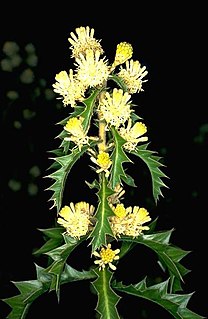
Petrophile carduacea is a species of flowering plant in the family Proteaceae and is endemic to southwestern Western Australia. It is a shrub with deeply toothed leaves, and more or less spherical heads of hairy yellow flowers.

Acacia trinervata, the three-veined wattle, is a species of flowering plant belonging to the genus Acacia and the subgenus Phyllodineae in the legume family Fabaceae.

Philotheca myoporoides subsp. myoporoides, commonly known as long-leaf wax flower, is a subspecies of flowering plant in the family Rutaceae and is endemic to south-eastern continental Australia. It is a shrub with oblong to elliptic or egg-shaped leaves and white or pink flowers arranged in groups of three to eight in leaf axils.

Dillwynia acicularis is a species of flowering plant in the family Fabaceae and is endemic to New South Wales. It is an erect shrub with linear, grooved leaves and yellow flowers with red markings.
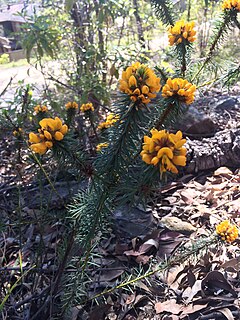
Pultenaea aristata, commonly known as bearded bush-pea or prickly bush-pea, is a species of flowering plant in the family Fabaceae and is endemic to New South Wales. It is a small, erect shrub with linear to narrow elliptic, sharp-tipped leaves, and yellow and red flowers.

Pultenaea capitellata, commonly known as hard-head bush-pea, is a species of flowering plant in the family Fabaceae and is endemic to south-eastern continental Australia. It is a sprawling to prostrate shrub with elliptic to broadly egg-shaped leaves, and yellow to orange flowers with a red to purple keel.

Pultenaea echinula, commonly known as curved bush-pea, is a species of flowering plant in the family Fabaceae and is endemic to a small area of New South Wales. It is an erect shrub with linear, needle-shaped, grooved leaves, and dense clusters of yellow to orange and red flowers.

Pultenaea euchila, commonly known as orange pultenaea, is a species of flowering plant in the family Fabaceae and is endemic to eastern Australia. It is an erect shrub with glabrous foliage, narrow egg-shaped leaves with the narrower end towards the base, and orange-coloured flowers arranged singly or in small groups near the ends of branchlets.


















